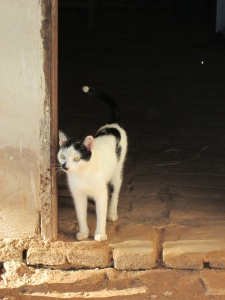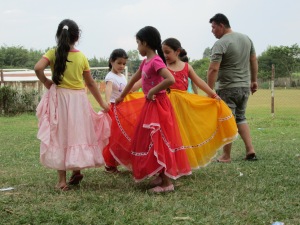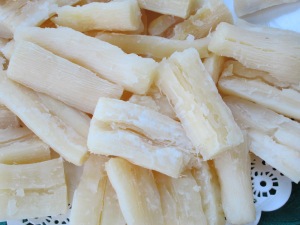 I traveled using the buses to Asunción for the first time on Wednesday. The other trainees and I were divided into pairs and tasked with getting to Asunción and to several locations throughout the city.
I traveled using the buses to Asunción for the first time on Wednesday. The other trainees and I were divided into pairs and tasked with getting to Asunción and to several locations throughout the city.
It was an adventure.
I left my house around 5:40 a.m. and met with several other volunteers to walk to the town center were we would meet our travel partners and catch our first bus.
The bus started comfortably full, but with every lurching stop there was less space as more people climbed onto the bus. Out the window I saw brink and stucco houses, some painted bright colors and others lighter hues of dirt. I read the painted signs on some—many faded or dented—of the house-front shops: “Coka-Cola,” “ice cream,” “ice” they declared. The breeze from the bus’ motion and the early start dampened the descending heat as the sun rose inch-by-inch.
People sitting slept with their bags clutched close and their heads against the windows. A man and woman standing behind me talked about a Peace Corps volunteer who lived with the woman—or maybe had lived with her in the past—the woman only said good things and I didn’t have the chance to see her face.
If it weren’t for the tightness of my calves from bracing against every jolt of the breaks, it wouldn’t have been as apparent that the ride was over an hour.
The traffic buzzed and the heat settled as we entered the outskirts of Asunción. Soon, I saw it, the bus terminal. It was the first stop on our journey. We needed to change buses.
We crowded onto another bus—the one that would take us to our first Peace Corps-assigned stop, a major market called Marcado 4. My host parents told me that I’d know when we got to the market because there’d be tons of stands and shops. There are very few signs, including road signs, in Asunción. Joyfully, I discovered my host parents were right: The market was obvious.
Marcado 4 had just opened. It wasn’t an open-air market and it wasn’t a mall. It was a warehouse divided into floors, each floor a winding maze of stands. Around the warehouse were more stands that opened onto the street but also to the inside of the warehouse. It was divided by theme. Bright shirts, sequin-encrusted tops, and selves of sandals shouted from the windows; deodorant, toothpaste, and soap piled high on crates; baskets of dog food, cat food, and herbs fouled the air with their pungent smell.
I bought cookies to tide me over until lunch. The market was still just waking up, but young women were already sitting outside the nail polish store. The women of Paraguay don’t just paint their nails—they turn their nails into art and change their color almost as often as their outfits.
We passed two men sawing the ribs off a side of beef and another man grinding up herbs with a pestle and mortar. My travel buddy and I spoke in our fragmented Spanish as we reviewed our assigned tasks and planned our next steps. We were looking for dental hygiene products. Toothpaste was easier to find, but toothbrushes were harder. I’ve yet to find dental floss, though people tell me it’s sold in supermarkets and in pharmacies. Our Asunción missions were related to dental hygiene because it is an important health topic in Paraguay. Many people here don’t brush their teeth regularly and dental care is expensive—as a volunteer I could help educate children about teeth brushing and why it’s important.
Our next stop was Paraguay’s Ministry of Health, specifically the dental and mouth division. We thought we found the building easily and sat in the shade, to wait. We were early. The ministry lives in a series of yellow buildings ranging in size and style. We wandered around the first building until we found someone who could help us. She said to go to a different building…two buildings later we finally found someone who could tell us where to find the person with whom we were supposed to talk.
We found our contact (well she actually found us, we must have looked lost) outside among a bunch of ministry vans. The vans are used to help people in really rural areas of Paraguay get medical treatment. Our contact was a doctor in the dental and mouth division of the ministry. She is an energetic woman with a large smile. She talks very quickly.
The ministry has three main dental health programs and materials that we could request to help with dental health trainings. All requests must be submitted in writing.
After our brief, though thorough, discussion of the ministry’s offerings and the doctor’s suggestions for how we could tackle dental health when we become volunteers, we were back on the street.
It was early and we were hungry so we popped into the closest, cheap eatery we found. It wasn’t glamorous, but they had one of the cleanest public restrooms I’ve used anywhere. I had a sandwich and yogurt. Did you know in Paraguay yogurt is often more liquid than solid. You eat it by drinking it, not with a spoon.
We wandered around trying to find the corner where we were supposed to catch our final bus. The directions made it sound easy. It was only a couple of blocks away, but somehow we couldn’t find it. We asked for directions. In Paraguay, I’ve been warned, people will give you directions if you ask even if they don’t know where the place about which you asked is. Because of this, it is advised that you ask for directions from more than one person.
We broke this rule. We ask one woman and then waited at the bus stop she was at, as she recommended. Luckily, at about the time we were starting to think maybe we should ask someone else she gave us different directions. Just like that we found the corner and were on our last bus.
The ride to the Peace Corps office, our last stop, was simple. We passed a soccer stadium and the United States embassy along the way. We heard about a brochure that had complete information about getting around Asunción and a man sing what may or may not have been a traditional Paraguayan song.
The Peace Corps office is in a compound, but once inside the buildings themselves are unassuming. Most importantly, the office has air conditioning. My group was the first to make it to the office…we were an hour early. The Olympics were on, and we even got to see some figure skating.
One mission down. Countless to go.
 Chuchi can be defined as fancy or big headed, but that’s not really a good translation. Let me try to explain “chuchi” in the context of Paraguayan culture.
Chuchi can be defined as fancy or big headed, but that’s not really a good translation. Let me try to explain “chuchi” in the context of Paraguayan culture.










